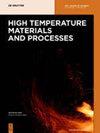使用 Fe2O3 对聚氯乙烯进行脱氯处理以及通过添加 SiO2 提高 FeCl2 中的氯固定率
IF 1.5
4区 材料科学
Q4 MATERIALS SCIENCE, MULTIDISCIPLINARY
引用次数: 0
摘要
摘要 在 673 K 以下的氩气环境中,对使用 Fe2O3 进行聚氯乙烯(PVC)脱氯进行了定量研究,同时还研究了加入 SiO2 对 PVC 和 Fe2O3 共热解的影响,目的是减少气态 Cl- 产物的排放。研究发现,通过 PVC 和 Fe2O3 的反应,PVC 中的氯可以固定在 FeCl2 中。PVC 和 Fe2O3 的共热解过程分为两个阶段,温度边界约为 543 K。在 543 K 以下,PVC 和 Fe2O3 发生直接反应,导致质量损失率较小,并在一定程度上固定了 FeCl2 中的氯。然而,在高于 543 K 时,PVC 开始分解,释放出气态 H2、HCl 等,通过两种可能的途径与 Fe2O3 反应生成 FeCl2。在途径 1 中,首先 Fe2O3 被 H2 还原成 Fe3O4,然后 Fe3O4 被 HCl 氯化成 FeCl2。在路径 2 中,首先 Fe2O3 被 HCl 氯化为 FeCl3,然后 FeCl3 被 H2 还原为 FeCl2。随着初始混合物中 PVC 含量的降低,FeCl2 中的氯固定比和挥发生成比也随之增加。加入 SiO2 会提高 FeCl2 中的氯固定率和挥发生成率,而且随着混合物中 PVC 含量的降低,影响会越来越大。对于含有 25% 聚氯乙烯的混合物,加入二氧化硅可将氯固定率从 70.8% 提高到 82.6%,而对于含有 90% 聚氯乙烯的混合物,加入二氧化硅对氯化铁中氯固定率的影响可以忽略不计。实验后在固体残留物中未检测到辉绿岩(Fe2SiO4)。用水浸法分离 FeCl2 后,滤渣是氧化铁和共轭多烯的复合体,可用作炼铁原料。本文章由计算机程序翻译,如有差异,请以英文原文为准。
De-chlorination of poly(vinyl) chloride using Fe2O3 and the improvement of chlorine fixing ratio in FeCl2 by SiO2 addition
Abstract A quantitative investigation of poly(vinyl) chloride (PVC) de-chlorination using Fe2O3, together with the impact of SiO2 addition on the co-pyrolysis of PVC and Fe2O3, was conducted below 673 K in an Ar atmosphere aiming to cut the emission of gaseous Cl⁻ products. It was found that chlorine in PVC can be fixed in FeCl2 by the reaction between PVC and Fe2O3. The co-pyrolysis of PVC and Fe2O3 proceeds in two stages with a temperature boundary of around 543 K. Below 543 K, a direct reaction occurs between PVC and Fe2O3, resulting in a small mass loss ratio and some extent of chlorine fixing ratio in FeCl2. However, above 543 K, PVC starts to decompose to release gaseous H2, HCl, etc., which react with Fe2O3 through two possible pathways to form FeCl2. In Pathway 1, first Fe2O3 is reduced to Fe3O4 by H2, followed by the chlorination of Fe3O4 to FeCl2 by HCl. In Pathway 2, first Fe2O3 is chlorinated to FeCl3 by HCl, followed by the reduction of FeCl3 to FeCl2 by H2. The chlorine fixing ratio in FeCl2 and the volatile generation ratio increase with decreasing PVC content in the initial mixtures. The addition of SiO2 promotes the chlorine fixing ratio in FeCl2 and volatile generation, and the impact gets stronger with decreasing PVC content in the mixtures. The chlorine fixing ratio is increased from 70.8 to 82.6% by SiO2 addition for the mixtures containing 25% PVC, whereas the difference in the chlorine fixing ratio in FeCl2 caused by SiO2 addition is negligible for the mixtures containing 90% PVC. Fayalite (Fe2SiO4) was not detected in the solid residues after the experiments. After separating FeCl2 using water leaching, the filter residue, a composite of iron oxide and conjugated polyene, can be used as a raw material for iron-making.
求助全文
通过发布文献求助,成功后即可免费获取论文全文。
去求助
来源期刊

High Temperature Materials and Processes
工程技术-材料科学:综合
CiteScore
2.50
自引率
0.00%
发文量
42
审稿时长
3.9 months
期刊介绍:
High Temperature Materials and Processes offers an international publication forum for new ideas, insights and results related to high-temperature materials and processes in science and technology. The journal publishes original research papers and short communications addressing topics at the forefront of high-temperature materials research including processing of various materials at high temperatures. Occasionally, reviews of a specific topic are included. The journal also publishes special issues featuring ongoing research programs as well as symposia of high-temperature materials and processes, and other related research activities.
Emphasis is placed on the multi-disciplinary nature of high-temperature materials and processes for various materials in a variety of states. Such a nature of the journal will help readers who wish to become acquainted with related subjects by obtaining information of various aspects of high-temperature materials research. The increasing spread of information on these subjects will also help to shed light on relevant topics of high-temperature materials and processes outside of readers’ own core specialties.
 求助内容:
求助内容: 应助结果提醒方式:
应助结果提醒方式:


